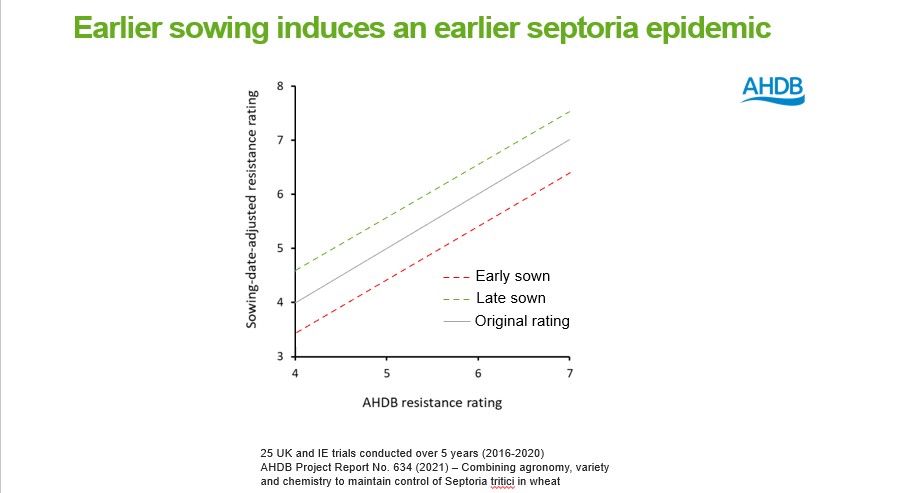Applying Revystar® XE (mefentrifluconazole+ fluxapyroxad) at T1, a fungicide with a proven track record, will protect and maximise the potential of the winter wheat crop across different seasons, disease situations and varieties.
With favourable conditions last autumn crops have established well, with the potential for high gross margins. The fungicide programme is key to building this, as the impact of maintaining a healthy canopy is hugely important to yield and the bottom line. By early February, a substantial amount of money, time and effort has already been invested in a crop of winter wheat, through labour, machinery costs, fuel, seed, fertiliser and herbicides.
Pat Thornton, of Low Melwood, near Doncaster has been with the BASF Real Results Circle since it began, trialling Revystar® XE on his winter wheat. He said, “For me it’s all about risk management and that risk is about return on investment. Once I come to that T1 decision making point I know that 60% of my costs are spent before I put any fungicide onto wheat. I’m in it and I am going to go on and get the best out of it.”
Four years of independent data

Jonathon Helliwell
Dr Jon Helliwell, BASF, Business Development Manager for Cereal Fungicides said, “There is now four years of independent data showing a clear benefit to Revystar® XE within a programme. Revystar® XE is now a key and proven benchmark for disease control in cereal crops.”
In 2021 Revystar® XE gave significant benefits in yield over AscraXpro (bixafen + fluopyram + prothioconazole), in what was perceived to be a low disease pressure scenario due to cold conditions at T1 and T2 decision making timings. 38 replicated T1 comparisons comparing 0.75 l/ha Revystar® XE to 1 l/ha AscraXpro gave an average benefit of 0.24 t/ha from applying Revystar® XE.

Richard Budd
Richard Budd, of Stevens Farm (Hawkhurst Ltd) in Kent achieved very strong results from using Revystar® XE at T1 where its curative properties tidied up the overwintered Septoria. He said, “This early protection against not just Septoria but other infections and stem based diseases ensured we had a healthy canopy reducing the chance of infection breaking out higher up the crop. This gives more flexibility if T2 applications are delayed.”
AHDB monitoring of Septoria
Data presented at the AHDB 2022 Agronomy conference found there has been absolutely no change in sensitivity to Revysol® against Septoria, it has remained rock solid over the last 4 years of independent Rothamsted resistance studies. Dr Helliwell said, “Revysol® remains the strongest partner to protect at risk modes of action.”
Mitigate Septoria risk from early drilling
In terms of Septoria risk, sowing date is a key factor.
An AHDB project undertaken by ADAS, NIAB TAG, SRUC involved 25 trials over 5 years and compared respective resistance ratings to official AHDB Recommended list (RL) trials, which had an average sowing date of the 7th of October.
Statisticians calculated that for crops drilled 2 weeks earlier than 7th October, the effective Septoria resistance rating on the RL list is decreased by 0.6 points, a finding which is stable across every variety rating. Conversely if crops are drilled 2 weeks later than the 7th October the effectively RL score is increased by 0.6 points.
Dr Helliwell said, “An early harvest and favourable autumn conditions meant that many winter wheat crops were drilled towards the end of September. This increases the effective Septoria risk in a crop, which needs to be considered as plans for Spring fungicide applications commence. Revystar® XE can mitigate this risk when used appropriately.

Counter Septoria risk from highly variable leaf layer emergence
Across BASF and independent trials, Revystar® XE is proven in both protective and curative situations a necessity in the field as potentially the fungicide will be targeting different stages of Septoria infection on the same crop.
Dr Helliwell said, “Leaf layer emergence dictates the time the leaves are exposed to Septoria infection and work that BASF have conducted with NIAB has shown that flag leaf emergence is highly variable even within the same field.”
Whilst variety seems to play a role in how uniformly leaves are emerging, the biggest driver to leaf development is thermal time.
“Cooler conditions which are common in the growing period before T1 may lead to a more varied emergence time of the same leaf layer within the crop. Growers may be faced with a situation where some leaves have been fully emerged for a number of days, whilst others are just emerging,” he said.
Delay the Septoria epidemic
Glasshouse trial work with ADAS in 2022 showed that a leaf treated with 0.75 l/ha of Revystar® XE gave an additional 6 days of Septoria-free leaf compared with 1 l/ha Univoq (fenpicoxamid + prothioconazole) at the same timing – a statistically significant delay to the Septoria epidemic.
Dr Helliwell said. “That delay in the epidemic is significant. It maintains a healthier leaf and may reduce the level of inoculum moving up the canopy. In crop protection terms, leaf 2 is the risky leaf which is not treated with fungicide until T2 and so if the epidemic reaching that leaf can be delayed, the healthy area duration of the canopy will be increased.”
Winter wheat is considered to be a source limited crop in the UK, a crop which often doesn’t have enough green leaf area to fulfil its yield potential. He added, “By applying Revystar ® XE we can reduce disease risk and maintain that green area for longer, leading to a longer grain filling period and higher yield.”
Lowering disease pressure may increase nitrogen uptake
Nitrogen has a key role in producing crop biomass and there is a well-established relationship between crop biomass and yield.
“Nitrogen uptake is influenced by a number of factors including variety, temperature, rainfall and crop disease. A high disease pressure situation will impart additional stress on the wheat crop which may in turn affect the ability of that crop to take up nitrogen. If we can control disease with an application of Revystar® XE then we may favourably alter the ability of the crop to uptake nitrogen,” Dr Helliwell said.




